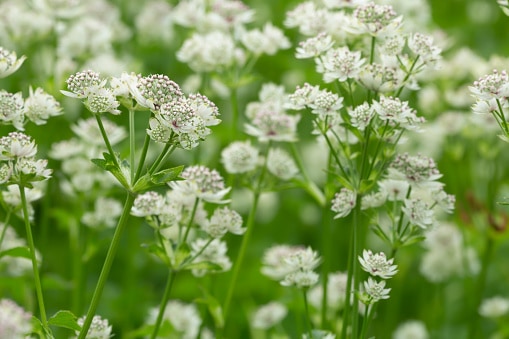Native to most of Europe, Majorwort (Astrantia major) is a woody perennial plant with unique and colorful clusters of tiny flowers densely clustered together. It has a neat habit, and the blooms sit on nearly black stems surrounded by lush leaves. It blooms in late spring to early summer and sporadically throughout the rest of the season when in ideal conditions. Typically, they require sunny and cool climates, with consistently moist soil to thrive.
The plant’s Latin name, Astrantia major, has an interesting origin. Astrantia stems from the Latin word aster, meaning star, and major, meaning large. This name is likely due to the star-shaped flowers that the plant produces.
How to plant
Majorwort plants can be grown both indoors and outdoors, as long as ideal conditions are met. Outdoor versions should be planted in well-drained and slightly acidic soils, and should be situated in an area that receives plenty of sun (about 5-6 hours a day). Majorwort plants prefer mild climates, but can be grown in zones 6 to 8, and should be sheltered from winter winds. The soil should be kept consistently moist and should be amended with organic matter to improve drainage.
Outdoor plants will benefit from an application of a 10-10-10 fertilizer once a month during the growing season. Indoor plants should be given an all-purpose houseplant fertilizer every 1-2 months.
Meaning and symbolism
Majorwort plants are popular in flower gardens and bouquets. In traditional European culture, they were often gifted during May Day celebrations or worn by unmarried women on their dresses as a symbol of their purity and femininity.
The meaning of the Majorwort itself goes beyond its European heritage. It is also thought to signify happiness and prosperity. In Christian culture, it is viewed as a symbol of Christ’s suffering and death due to its spiny thorns which were compared to the nails used in the crucifixion.
History, mythology and religious significance
Majorwort plants have been a part of human history since antiquity. In the writings of ancient Greek scholars, they were referred to by the name Chrysanthemas, which means “golden flower” in Greek. During the medieval period, they were associated with the Virgin Mary and were often planted around churches and monasteries. Their flowers were also used in religious ceremonies and rituals, and in some cases, their leaves were used as a source of healing.
More modern cultures have also adopted Majorwort as a symbol of strength, resilience and protection. In some parts of Asia, the plant is associated with courage and bravery, and in certain circles, its leaves are used to ward off evil spirits.
Flower varieties and their defining characteristics
Majorwort is a species within the plant genus Astrantia and is typically characterized by its yellow, star-shaped flowers that are clustered together. Majorwort comes in multiple varieties, each with its own unique characteristics:
- Astrantia major ‘Hocus Pocus’: This variety produces white flowers with pinkish-purple tips and yellow centers. It has dense foliage with burgundy stems and reddish-purple bracts.
- Astrantia major ‘Hadspen Blood’: This variety has deep red flowers and bracts with a yellow throat. The foliage is oval-shaped and has a silvery sheen.
- Astrantia major ‘Star of Beauty’: This variety has deep purple flowers with yellow centers and luxurious foliage. The bracts are coppery-pink and the stems are black.
- Astrantia major ‘Peachy’: This variety has peachy-pink flowers with yellow centres and white bracts. Its foliage is variegated and has shades of pink, green, and cream.
Common pests and diseases
Majorwort is generally disease and pest resistant, but can be affected by mildew, rust and aphids. Mildew is caused by overwatering and can be treated with fungicides. Rust and aphids can be removed with insecticidal soap or horticultural oil solutions. Regular preventive maintenance will help prevent any diseases or pests from taking hold.
How to pot and repot
Majorwort plants should be potted in a well-draining potting mix that is lightly amended with organic matter. The potting mix should be a mix of one part peat moss and one part perlite. Potting soil should have a pH between 6.5-7.5, and the soil should be slightly moist. When potting, it is important to use a pot with adequate drainage holes and to use pots that are slightly larger than the root ball.
When repotting Majorwort plants, it is important to be gentle as the root ball can be delicate. Once the soil has been loosened from the sides of the pot, the root ball can be carefully removed and placed in its new container, with some of its old potting soil mixed in with new soil.
How to prune
Majorwort plants should be pruned in the spring, after the initial flowering has finished. Pruning will help maintain the size and shape of the plant and will also stimulate new growth. It is important to remove any dead or dying flowers, stems and leaves and to shape the plant if needed. This will help keep the plant healthy and allow for more blooms.
How to propagate
Majorwort can be easily propagated from seed, division and cuttings. To propagate from seed, the seeds should be sown in the spring and should be kept moist and in a warm environment until germination. Division should be done in the fall, when the plant is dormant and can easily be taken apart into several pieces. To propagate from cuttings, take a 4 inch long cutting and let it sit in water until new roots are formed, then pot the cutting in a potting mix.
Three frequently asked questions about Astrantia major
- Can Majorwort be grown in pots?
Yes, Majorwort grows well in pots and can be grown both indoors and outdoors. Make sure the pot has plenty of drainage holes and use a well-draining potting mix that is slightly acidic. - How often should Majorwort be watered?
Majorwort should be watered once a week. Water the soil until it is damp and then let it dry out slightly before watering again. Avoid overwatering, as this can lead to root rot. - When should Majorwort be fertilized?
Majorwort should be fertilized once a month during the growing season (spring and summer). For outdoor plants, use a 10-10-10 fertilizer, and for indoor plants, use an all-purpose houseplant fertilizer.
Fact sheet facts
| Majorwort | Astrantia major |
|---|---|
| Family | Apiaceae |
| Plant Type | Perennial |
| Mature Size | 1-2ft tall |
| Sun Exposure | Full sun to partial shade |
| Soil Type | Well drained, slightly acidic |
| Soil pH | 6.5-7.5 |
| Bloom Time | Late spring to early summer |
| Flower Color | White with pinkish-purple tips, deep red, deep purple, peachy-pink |
| Hardiness Zones | 6-8 |
| Native Area | Most of Europe |
What we love from Amazon this week
Buy these wonderful flowers directly from Amazon:















